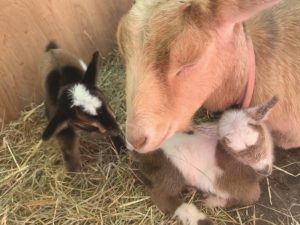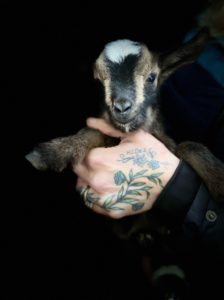Last summer our sweet Nigerian dwarf doe, Princess Buttercup, gave birth with remarkable ease, which is typical for her breed. I barely noticed that she was in labor before her first push, accompanied by a loud bleat, caught my attention. Less than 10 minutes later, both her kids were born. I remember thinking to myself: no wonder there is no need for a vet to be present.

This year, though, Buttercup kept us waiting. We weren’t certain of her exact due date, but although she was huge and uncomfortable, she didn’t seem in any distress. We weren’t worried.
And we were prepared. My husband, Russell, had installed a baby monitor in the birthing suite (a separate corner of her stall) so that I could keep an eye on her day and night. I barely left the house, and went out to check on her every few hours, even at night. Though does give birth without trouble more than 95 percent of the time, it is better to be by her side, just in case. Newborn kids often need help clearing their airways before taking their first breath, and because most does — and especially this breed — carry more than one kid per pregnancy, they can get behind on that task.
Our birthing kit was well-stocked: puppy pads for the babies to land on; surgical gloves; towels to pick up the just-born kids so they don’t slip out of your hands. The doe will lick her babies dry — an important part of her accepting and bonding with them. But if it is a multiple birth, she may take a while, and since newborn kids shouldn’t get cold, sometimes you will need to dry them off a little before mama can get down to the task herself. Our kit also contained dental floss to tie off the umbilical cord and iodine for the wound; electrolytes and molasses for the exhausted mama after labor; and lubricant. Because you may need to reach inside a doe to dislodge a stuck baby. This happens only rarely — in 1 to 2 percent of births.
For us, the weeks of monitoring and waiting dragged on. Buttercup, though, enjoyed all the attention. One of the signs that goats are close to labor is that they seek human contact and become more affectionate. Each time I checked on Buttercup, she greeted me with a gentle nudge and sidled up to me for a belly rub. I promised her that whatever might happen, she could count on me.
It was during a 4 a.m. check that I realized Buttercup was going to give birth at last. Her water broke around 9, and she began to push. I donned my gloves, spread out the puppy pads, encouraged her with each effort and waited, ready to catch babies. But no babies came. We reached the dreaded 30-minutes-of-pushing threshold, which could indicate a problem. I called our vet, but she didn’t answer.
I was glad Russell was home, and my nephew was in the birthing pen with me, as planned. Goats often give birth lying down, but when Buttercup laid her head down, we knew something was wrong. “What should I do?” I asked. “Do I have to reach in?” Russ’s eyes told me that this was an emergency, that I had to.

I put on new gloves and covered my hand and arm in lube. When I reached inside the birthing canal, I felt a spine. A kid should come out nose and hooves first. The breech position (rump first) is dangerous for both kid and doe. I turned the kid as best I could, Buttercup pushed, and the kid slipped out. Buttercup would survive, but the kid was dead.
There was nothing we could do. I handed the tiny body to my husband. Then came the second kid, weak, but alive, and the third — this all-male litter would have been a disappointment at a dairy farm. Our vet called back. Breech births are slightly more common with males. She was amazed that two of the kids had survived. The delay could easily have caused a worse outcome.
Death is part of life and part of having a farm. We have seen death at our homestead before, but nothing this traumatic. Our daughters know this story, but I am glad they were in school when it happened. Over the days that followed, as we watched Buttercup care for her two lively boys, and we welcomed them with cuddles and love ourselves, we all began to heal.



